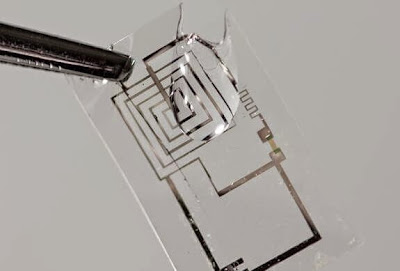1. Implantable Smartphones
Of course, we are virtually connected to our smartphones all the time, but what if we were physically connected to our smartphones? Indeed, that has already begun to happen. Last year artist Anthony Antonellis had an RFID chip embedded in his arm that could save and transfer small art to the smartphone.
But what would replace the Display? Well, Autodesk engineers are experimenting with a system that could display images through the artificial skin. Even studying the possibility of eye implants to display visuals, capture an image then transfer it to any local storage. Researchers are also experimenting with bone-conduction speakers that convert human bones into living speakers.
2. Smart Organs
The idea is simple. Grow up a large quantity of the cells from the patient, then feed them to bioprinter and create an organ. There will be no fear of rejection and no need for immunosuppressant drugs. We already succeeded in making skin for patients with burns.
3. Contraceptive Microchip
Unlike Intrauterine Contraceptive Device (IUCD), this tiny chip releases small amounts of a contraceptive hormone by using an external remote control. This project is an initiative of Massachusetts Institute of Technology (MIT) and is being supported by the Gates Foundation.
- Bill Gates's Contraceptive Microchip Will Be Ready In 2018
- 3 Ways Modern Technology Can Help You Achieve A Zen Mind
- 3 Ways Modern Technology Can Help You Achieve A Zen Mind
4. Healing Chips
Patients are already using cyber-implants that connected to smartphone applications to monitor and treat diseases in real time. Teams at Boston University testing a new bionic pancreas have small needles and the sensor, which communicates with a smartphone application to control blood sugar levels of diabetics.
In 2013, ETH Zurich research group designed genetic regulatory circuit mainly composed of human gene components. It constantly monitors the fat in obese patients and also generates genetic material that makes them feel satisfied.
5. Brain-computer Interface

Having the human brain directly connected to computers is the dream of science fiction. The BrainGate project is developing a brain-computer interface able to convert a thought into action to help people with disabilities. Thanks to this system, some Tetraplegic patients can now reach and grasp objects with a robotic arm. Chip maker Intel predicts practical computer-brain interfaces by 2020. Imagine being able to browse the web with the power of your thoughts, that’s cool.
6. Smart Tattoos
 Tattoos are always in vogue and apparently everywhere. Why not make it smart? Digital tattoos not only look good, but can also perform useful tasks such as unlock your car or entering passwords on your Gadget.
Tattoos are always in vogue and apparently everywhere. Why not make it smart? Digital tattoos not only look good, but can also perform useful tasks such as unlock your car or entering passwords on your Gadget.
Researchers already developed Nano-Optodes that can be injected under the skin, like tattoo ink, and can change color according to glucose level. Joseph Wang, a researcher from UCSD, come up with a new smart tattoo that can produce electricity from sweat and could power future wearable gadgets.
7. Cyber Pills
This implant not only connected to your smartphone, but this will communicate with the doctor as well. Proteus Digital Health developed ingestible sensors that have microprocessors able to send messages to physicians. The pills can share information to help caregivers if the patients are not taking medication correctly and whether it is not having the desired effect.
8. Smart Dust
Perhaps the most surprising of implantable innovations is the smart dust, each smaller than a grain of sand, which can be organized within the body-as precise networks to perform complex internal processes. Applications include attacking early cancer cells or relieving pain due to injury or even storing personal information so that it is strongly encrypted and difficult to hack.
9. Biodegradable Battery
One of the biggest challenges facing the implantable technology is the way to get energy for powering devices implanted inside a human body. A team at Draper laboratory in Cambridge is working on biodegradable batteries. They generate energy within the body and then just dissolve without harming body. Another project is under consideration, is to use the body's own glucose for energy.
10. ID Chip
 This technology will allow identification of every human through a smart tag. The US military already has ongoing programs aimed to equip soldiers with RFID chips, to keep track of troops is automated and worldwide. The advantages of this would include improvement in the fight against crime, secure elections, and locating missing persons.
This technology will allow identification of every human through a smart tag. The US military already has ongoing programs aimed to equip soldiers with RFID chips, to keep track of troops is automated and worldwide. The advantages of this would include improvement in the fight against crime, secure elections, and locating missing persons.
Related:
- Bill Gates's Contraceptive Microchip Will Be Ready In 2018
- Top 10 Ethical Issues Of The Future Of Medicine







You should give credit to the real author and not just post a bunch a lot of irrelevant links as the source.
ReplyDeleteHere is the real article, published in 2014:
https://wtvox.com/3d-printing-in-wearable-tech/top-10-implantable-wearables-soon-body/
I have also contacted WT VOX to let them know.
Appreciate your comment. As you pointed out, both article are similar. Before you accuse me, you should check this article from Yahoo Tech, published in Oct 8, 2014.
DeleteNine real technologies that will soon be inside you ( https://www.yahoo.com/tech/9-signs-that-implantable-technology-c1412123685694.html )